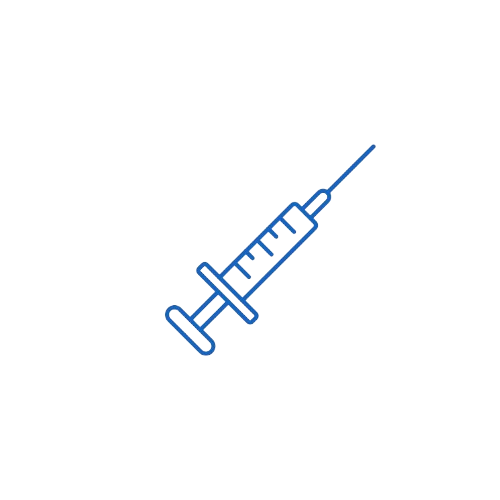Ranibizumab
Allopathic
Medicines List
All MedicineIndications
Approved Indications:
- Neovascular (wet) Age-Related Macular Degeneration (AMD):
- For treatment of patients with wet AMD to improve visual acuity and prevent further vision loss.
- Macular Edema following Retinal Vein Occlusion (RVO):
- For macular edema secondary to branch or central retinal vein occlusion (BRVO or CRVO).
- Diabetic Macular Edema (DME):
- For treatment of visual impairment due to DME in patients with diabetic retinopathy.
- Diabetic Retinopathy (DR):
- For all stages of DR, with or without associated DME.
- Myopic Choroidal Neovascularization (mCNV):
- For patients with visual impairment due to CNV secondary to pathological myopia.
Clinically Accepted Off-Label Uses:
- Retinopathy of Prematurity (ROP):
- Investigational and off-label use for stage 3+ ROP in zone I or posterior zone II in neonates (based on growing clinical data).
Dosage & Administration
Adults:
- Neovascular AMD:
- 0.5 mg (0.05 mL) intravitreal injection once monthly (every 28 days).
- May be extended to once every 2 or 3 months after the first 3 monthly doses depending on response.
- Macular Edema following RVO:
- 0.5 mg intravitreal injection monthly until maximum visual acuity is achieved and/or absence of disease activity.
- Diabetic Macular Edema / Diabetic Retinopathy:
- 0.3 mg (U.S.) or 0.5 mg (EU) intravitreal once monthly; can be extended to every 2–3 months after stabilization.
- Myopic CNV:
- 0.5 mg single intravitreal injection; further treatment based on clinical need.
Pediatrics:
- Retinopathy of Prematurity (ROP):
- Off-label: Doses range from 0.2 to 0.3 mg intravitreally per eye, typically as a single dose; follow-up required.
Elderly:
- No dose adjustment needed; monitor closely for systemic vascular events.
Renal/Hepatic Impairment:
- No dose adjustment required; limited systemic exposure due to intravitreal route.
Administration:
- Route: Intravitreal injection by a trained ophthalmologist.
- Technique: Use under aseptic conditions with pre- and post-injection antibiotic prophylaxis.
Mechanism of Action (MOA)
Ranibizumab is a recombinant humanized monoclonal antibody fragment (Fab) that binds with high affinity to all isoforms of vascular endothelial growth factor A (VEGF-A). By inhibiting VEGF-A binding to its receptors (VEGFR-1 and VEGFR-2) on the surface of endothelial cells, it suppresses abnormal blood vessel formation (neovascularization) and vascular permeability. This reduces edema, leakage, and abnormal blood vessel growth in retinal tissues, thereby improving or stabilizing vision in various retinal vascular diseases.
Pharmacokinetics
- Absorption: Rapidly absorbed after intravitreal injection; peak intraocular concentration within 1 day.
- Bioavailability: Limited systemic exposure; serum levels ~90,000-fold lower than intraocular levels.
- Distribution: Confined largely to ocular tissues; systemic distribution minimal.
- Metabolism: Broken down via proteolytic catabolism into small peptides and amino acids.
- Half-life:
- Intraocular: ~9 days.
- Systemic: ~2 hours (low systemic levels).
- Excretion: Systemic clearance through normal protein catabolic pathways.
Pregnancy Category & Lactation
- Pregnancy:
- FDA Category: Not assigned under PLLR. Animal studies showed possible teratogenicity and embryo-fetal toxicity. Avoid use in pregnancy unless absolutely necessary.
- Lactation:
- Unknown if excreted in human milk. Minimal systemic exposure expected after intravitreal administration, but caution advised, especially during the first postpartum months.
Therapeutic Class
- Primary Class: Ophthalmic Agent
- Subclass: Anti-VEGF Monoclonal Antibody Fragment (Antiangiogenic Agent)
Contraindications
- Hypersensitivity to Ranibizumab or any component of the formulation
- Ocular or periocular infections
- Active intraocular inflammation (e.g., uveitis, endophthalmitis)
- Uncontrolled glaucoma (relative contraindication)
Warnings & Precautions
- Endophthalmitis:
- Risk after injection. Use strict aseptic technique and monitor for signs of infection post-injection.
- Increased Intraocular Pressure (IOP):
- Monitor IOP before and after injection. May require pre-treatment in glaucoma patients.
- Thromboembolic Events:
- Low but possible systemic risk (e.g., stroke, myocardial infarction), particularly in patients with underlying risk factors.
- Retinal Detachment or Tear:
- Careful injection technique required; monitor after each injection.
- Bilateral Treatment:
- Not recommended on the same day due to compounded risks of bilateral complications.
Side Effects
Common:
- Conjunctival hemorrhage
- Eye pain
- Increased IOP
- Vitreous floaters
- Intraocular inflammation
Less Common:
- Blurred vision
- Dry eye
- Photopsia (flashing lights)
- Foreign body sensation
Serious (Rare):
- Endophthalmitis
- Retinal detachment
- Arterial thromboembolic events (e.g., stroke, MI)
- Traumatic cataract
- Anaphylaxis (extremely rare)
Onset & Dose-dependence:
- Most adverse effects occur within 1–7 days post-injection; cumulative risks increase with repeated dosing.
Drug Interactions
- Systemic Antithrombotic Agents (e.g., warfarin, clopidogrel):
- Theoretical increased risk of systemic bleeding or vascular events; monitor if used concurrently.
- Other Intravitreal Agents:
- Increased risk of intraocular inflammation and toxicity if co-administered or used too closely in timing.
- No CYP450 Interaction:
- Ranibizumab is not metabolized via CYP enzymes; unlikely to interact with hepatic-metabolized drugs.
Recent Updates or Guidelines
- Diabetic Retinopathy Guidelines:
- Endorsed by AAO and ADA as a first-line agent for center-involved DME and proliferative DR.
- ROP Research:
- Ranibizumab gaining acceptance as a safer anti-VEGF alternative to bevacizumab in premature infants, with emerging data supporting individualized low-dose use.
- Biosimilar Approvals:
- Biosimilars of Ranibizumab (e.g., Razumab, Byooviz) are now available in several countries, lowering treatment costs.
Storage Conditions
- Temperature Range:
- Store in a refrigerator at 2°C to 8°C (36°F to 46°F). Do not freeze.
- Protection:
- Keep in original carton to protect from light.
- Handling:
- Do not shake. Use aseptic technique during preparation and administration.
- After Opening:
- Use immediately after puncturing the vial. Do not store for later use.
